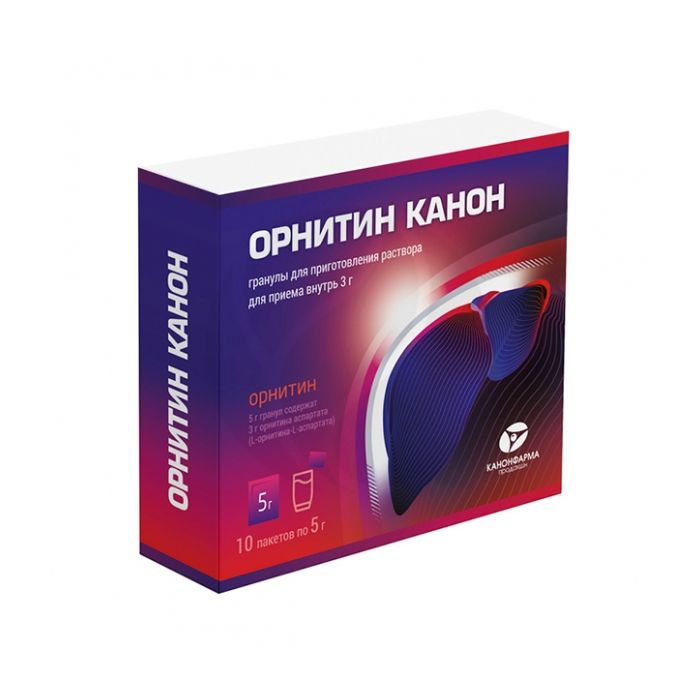Ornithine granules for preparation of oral suspension 3g, No. 10
Expiration Date: 11/2025
Russian Pharmacy name:
Орнитин гранулы для приготовления суспензии для приема внутрь 3г, №10
Acute and chronic liver diseases accompanied by hyperammonemia. Hepatic encephalopathy (latent and severe). Steatoses and steatohepatitis (of various origins).
Inside, 1-2 sachets of granules, dissolved in 200 ml of liquid, 2-3 times a day after meals.
The course of administration depends on the severity of the disease.
Active ingredient: ornithine (L-ornithine-L-aspartate) - 3.0 g.
Excipients: orange flavor - 0.2 g, lemon flavor - 0.02 g, sodium saccharinate - 0.0045 g, sodium cyclamate - 0 , 0405 g, anhydrous citric acid - 0.55 g, fructose - 1.1345 g, povidone (K-30) - 0.05 g, sunset yellow dye - 0.0005 g.
Severe renal failure with a creatinine value of more than 3 mg / 100 ml, hypersensitivity to drug components, breastfeeding period, children under 18 years of age (due to insufficient data), fructose intolerance.
Carefully
Pregnancy.
Trade name:
Ornithine
International non-proprietary or group name:
ornithine
Dosage form:
granules for preparation of oral solution
Composition for one package:
Active ingredient: ornithine (L-ornithine-L-aspartate) - 3.0 g.
Excipients: orange flavor - 0.2 g, lemon flavor - 0.02 g, sodium saccharinate - 0.0045 g, sodium cyclamate - 0 , 0405 g, anhydrous citric acid - 0.55 g, fructose - 1.1345 g, povidone (K-30) - 0.05 g, sunset yellow dye - 0.0005 g.
Description:
a mixture of white and orange granules with the smell of lemon and orange. Powder is allowed.
Pharmacotherapeutic group:
drugs for the treatment of liver diseases.
Pharmacological properties
Pharmacodynamics. It has a detoxifying effect, reducing the increased level of ammonia in the body, in particular, in liver diseases. The action of the drug is associated with its participation in the ornithine cycle of Krebs urea formation (activates the cycle, restoring the activity of liver cell enzymes, ornithinecarbamoyltransferase and carbamoylphosphate synthetase). Promotes the production of insulin and growth hormone. Improves protein metabolism in diseases requiring parenteral nutrition. It helps to reduce asthenic, dyspeptic and pain syndrome, as well as to normalize increased body weight (with steatosis and steatohepatitis).
Pharmacokinetics.L-ornithine-L-aspartate rapidly dissociates into ornithine and aspartate and begins to act within 15-25 minutes, with a short half-life. It is excreted in the urine through the urea cycle.
Indications for use
Acute and chronic liver diseases accompanied by hyperammonemia. Hepatic encephalopathy (latent and severe). Steatoses and steatohepatitis (of various origins).
Contraindications
Severe renal failure with a creatinine value of more than 3 mg / 100 ml, hypersensitivity to drug components, breastfeeding period, children under 18 years of age (due to insufficient data), fructose intolerance.
Carefully
Pregnancy.
Application during pregnancy and during breastfeeding
The effect of the drug on pregnancy and breastfeeding in humans has not been studied.
The drug should not be used during pregnancy, unless absolutely necessary, if the potential benefit to the mother significantly outweighs the potential risk to the fetus.
The drug should not be used during breastfeeding. If therapy is necessary, breastfeeding should be discontinued.
Method of administration and dosage
Inside, 1-2 sachets of granules, dissolved in 200 ml of liquid, 2-3 times a day after meals.
The course of administration depends on the severity of the disease.
Side effect
The frequency of adverse reactions is presented according to the following classification (classification of the World Health Organization):
very often:? 1/10,
often: from? 1/100 to <1/10,
infrequently: from? 1/1000 to <1/100,
rarely: from? 1/10000 to <1/1000
very rarely: from <1/10000, including individual messages, the
frequency is unknown: (the frequency cannot be calculated from the available data).
Immune system disorders,
frequency unknown: allergic reactions.
Disorders from the gastrointestinal tract are
infrequent: nausea, vomiting, abdominal pain, flatulence, diarrhea.
Musculoskeletal and connective tissue disorders are
very rare: pain in the limbs.
Overdose
Symptoms: increased severity of side effects.
Treatment: gastric lavage, intake of activated charcoal, symptomatic therapy.
Interaction with other medicinal products
Not described.
special instructions
When diagnosing 'hepatic encephalopathy' due to the underlying disease, it is necessary to observe increased caution when driving vehicles and engaging in other potentially hazardous activities that require increased concentration of attention and speed of psychomotor reactions.
Influence on the ability to drive vehicles, mechanisms
The drug does not affect the ability to drive vehicles or engage in other potentially hazardous activities.
Release form
Granules for preparation of oral solution, 3 g.
Shelf life
3 years.
Do not use after the expiration date.
Storage conditions
At a temperature not higher than 25 ? C.
Keep out of the reach of children.
Vacation conditions
Available without a prescription.

